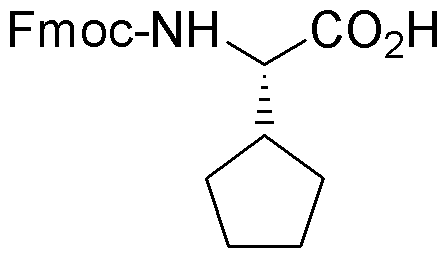Fmoc-L-cyclopentylglycine is widely utilized in research focused on
- Peptide Synthesis: This compound serves as a valuable building block in the synthesis of peptides, particularly in solid-phase peptide synthesis (SPPS), allowing for the creation of complex peptide structures with high purity.
- Drug Development: It plays a crucial role in the design of peptide-based drugs, offering unique properties that can enhance the efficacy and specificity of therapeutic agents in treating various diseases.
- Bioconjugation: Fmoc-L-cyclopentylglycine can be used in bioconjugation processes, facilitating the attachment of peptides to other biomolecules, which is essential in developing targeted drug delivery systems.
- Research in Neuroscience: This compound is utilized in studies related to neuropeptides, helping researchers understand the role of specific peptides in neurological functions and potential treatments for neurological disorders.
- Custom Peptide Libraries: It is instrumental in creating custom peptide libraries for high-throughput screening, enabling researchers to discover new bioactive peptides for various applications in biotechnology and pharmaceuticals.
General Information
Properties
Safety and Regulations
Applications
Fmoc-L-cyclopentylglycine is widely utilized in research focused on
- Peptide Synthesis: This compound serves as a valuable building block in the synthesis of peptides, particularly in solid-phase peptide synthesis (SPPS), allowing for the creation of complex peptide structures with high purity.
- Drug Development: It plays a crucial role in the design of peptide-based drugs, offering unique properties that can enhance the efficacy and specificity of therapeutic agents in treating various diseases.
- Bioconjugation: Fmoc-L-cyclopentylglycine can be used in bioconjugation processes, facilitating the attachment of peptides to other biomolecules, which is essential in developing targeted drug delivery systems.
- Research in Neuroscience: This compound is utilized in studies related to neuropeptides, helping researchers understand the role of specific peptides in neurological functions and potential treatments for neurological disorders.
- Custom Peptide Libraries: It is instrumental in creating custom peptide libraries for high-throughput screening, enabling researchers to discover new bioactive peptides for various applications in biotechnology and pharmaceuticals.
Documents
Safety Data Sheets (SDS)
The SDS provides comprehensive safety information on handling, storage, and disposal of the product.
Product Specification (PS)
The PS provides a comprehensive breakdown of the product’s properties, including chemical composition, physical state, purity, and storage requirements. It also details acceptable quality ranges and the product's intended applications.
Certificates of Analysis (COA)
Search for Certificates of Analysis (COA) by entering the products Lot Number. Lot and Batch Numbers can be found on a product’s label following the words ‘Lot’ or ‘Batch’.
*Catalog Number
*Lot Number
Certificates Of Origin (COO)
This COO confirms the country where the product was manufactured, and also details the materials and components used in it and whether it is derived from natural, synthetic, or other specific sources. This certificate may be required for customs, trade, and regulatory compliance.
*Catalog Number
*Lot Number
Safety Data Sheets (SDS)
The SDS provides comprehensive safety information on handling, storage, and disposal of the product.
DownloadProduct Specification (PS)
The PS provides a comprehensive breakdown of the product’s properties, including chemical composition, physical state, purity, and storage requirements. It also details acceptable quality ranges and the product's intended applications.
DownloadCertificates of Analysis (COA)
Search for Certificates of Analysis (COA) by entering the products Lot Number. Lot and Batch Numbers can be found on a product’s label following the words ‘Lot’ or ‘Batch’.
*Catalog Number
*Lot Number
Certificates Of Origin (COO)
This COO confirms the country where the product was manufactured, and also details the materials and components used in it and whether it is derived from natural, synthetic, or other specific sources. This certificate may be required for customs, trade, and regulatory compliance.


